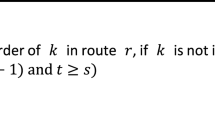Abstract
We consider the problem of scheduling in wireless sensor networks for the purposes of aggregation convergecast. We observe that existing schemes adopt essentially a two phase approach, consisting of, first, a tree construction and, second, a scheduling phase. Following a similar approach, we propose two new improvements, one to each of the two phases. Starting with a new lower bound on the schedule length, we make use of it in the tree construction phase. The tree construction phase consists of solutions to instances of bipartite graph semi-matchings. The scheduling phase is a weight-based priority scheme that obeys dependency (tree) and interference constraints. Our extensive experiments show that, overall, our proposed solution not only outperforms all previously proposed solutions in terms of schedule length, but it also significantly extends the network’s lifetime.








Similar content being viewed by others
Notes
That meets the constraints outlined in Sect. 2.
In this paper whenever we mention an optimal semi-matching, we mean that the semi-matching is optimal with respect to L ∞ norm.
Because of ties many nodes could produce the same value.
PER is defined as the ratio of the number of packets that were received successfully over the number of packets that were transmitted.
References
Intel lab data. http://db.csail.mit.edu/labdata/labdata.html.
Annamalai, V., Gupta, S. K. S., & Schwiebert, L. (2003). On tree-based convergecasting in wireless sensor networks. Proceedings of the IEEE Conference on Wireless Communications and Networking (WCNC’03), 3, 1942–1947.
Chen, X., Hu, X., & Zhu, J. (2005). Minimum data aggregation time problem in wireless sensor networks. Lecture Notes in Computer Sciences, 3794, 133–142.
Harvey, N. J. A., Ladner, R. E., Lovász, L., & Tamir, T. (2006). Semi-matchings for bipartite graphs and load balancing. Journal of Algorithms, 59(1), 53–78.
Heinzelman, W. H., Chandrakasan, A., & Balakrishnan, H. (2000). Energy-efficient communication protocol for wireless microsensor networks. Proceedings of the 33rd Annual Hawaii International Conference on System Sciences, 2, 1–10.
Huang, S. C.-H., Wan, P.-J., Vu, C. T., Li, Y., & Yao, F. (2007). Nearly constant approximation for data aggregation scheduling in wireless sensor networks. Proceedings of the 26th Conference on Computer Communications (INFOCOM’07), pp. 366–372.
Kesselman, A., & Kowalski, D. R. (2006). Fast distributed algorithm for convergecast in ad hoc geometric radio networks. Journal of Parallel and Distributed Computing, 66(4), 578–585.
Madden, S., Franklin, M. J., Hellerstein, J. M., & Hong W. (2002). TAG: A tiny aggregation service for ad-hoc sensor networks. Proceedings of the 5th symposium on Operating systems design and implementation (OSDI’02), 36, 131–146.
Malhotra, B., Nascimento, M. A., & Nikolaidis, I. (2009). Exact top-k queries in wireless sensor networks. Technical Report TR09-16, Dept. of Computing Science, Univ. of Alberta.
Silberstein, A., Munagala, K., & Yang, J. (2006). Energy-efficient monitoring of extreme values in sensor networks. Proceedings of the ACM Conf. on Management of Data (SIGMOD’06), pp. 169–180.
Wan, P.-J., Alzoubi, K. M., & Frieder, O. (2004). Distributed construction of connected dominating set in wireless ad hoc networks. Mobile Networks and Applications, 9(2), 141–149.
Wan, P.-J., Huang, S. C.-H., Wang, L., Wan, Z., & Jia, X. (2009) Minimum-latency aggregation scheduling in multihop wireless networks. Proceedings of the 10th ACM International Symposium on Mobile Ad Hoc Networking and Computing (MOBIHOC’09), pp. 185–194.
Wu, M., Xu, J., Tang, X., & Lee, W.-C. (2007). Top-k monitoring in wireless sensor networks. IEEE Transactions on Knowledge and Data Engineering, 19(7), 962–976.
Yu, B., Li, J., & Li, Y. (2009). Distributed data aggregation scheduling in wireless sensor networks. Proceedings of the 28th Conference on Computer Communications (INFOCOM’09).
Yu, X., Mehrotra, S., & Venkatasubramanian, N. (2007). Sensor scheduling for aggregate monitoring in wireless sensor networks. Proceedings of the 19th International Conference on Scientific and Statistical Database Management (SSDBM’07), p. 24.
Zhu, J., & Hu, X. (2008). Improved algorithm for minimum data aggregation time problem in wireless sensor networks. Journal of Systems Science and Complexity, 21(4), 626–636.
Acknowledgments
Thanks to the anonymous reviewers and the editor for their valuable suggestions. Thanks are also due to Xujin Chen [3], Nicholas Harvey [4], Scott Huang [6], Bo Yu [14] and Jianming Zhu [16] for providing some important clarifications regarding their work to the authors of this paper. This research is partially supported by iCORE and NSERC.
Author information
Authors and Affiliations
Corresponding author
Rights and permissions
About this article
Cite this article
Malhotra, B., Nikolaidis, I. & Nascimento, M.A. Aggregation convergecast scheduling in wireless sensor networks. Wireless Netw 17, 319–335 (2011). https://doi.org/10.1007/s11276-010-0282-y
Published:
Issue Date:
DOI: https://doi.org/10.1007/s11276-010-0282-y




